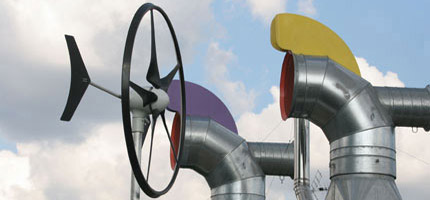
The good news is that we know exactly what needs to be done to stop climate change - and the technologies we need already exist. With the right policies at national and local levels, we would be able to deploy them on a large scale.
Clean energy
Two thirds of all energy going into the UK's power stations is lost as waste heat - up the chimney and in the cooling towers. If we captured this waste heat, there would be enough of it to heat every building and business in the UK.
To capture and use this heat, we would need to stop relying on our archaic, centralised energy system and start producing energy in smaller, local combined heat and power (CHP) plants. A number of countries around the world are already doing this; the UK needs to follow their example and undergo an energy revolution. With a decentralised energy system based on renewable technologies, we could double the efficiency of our power stations, slash our carbon emissions and reduce our reliance on foreign gas.
Transport
Transport is responsible for 22 percent of the UK's carbon emissions, and vehicles in the UK are pumping out more greenhouse gases than ever before. At the moment, EU car manufacturers only have a voluntary agreement to reduce the emissions of their cars. To make real progress towards low carbon cars, binding efficiency targets need to be imposed on manufacturers and gas-guzzlers need to be taxed more highly.
Aviation is the fastest growing cause of climate change in the world, and the popularity of short haul flights is still growing. According to the Tyndall Centre, if air traffic is allowed to keep growing at its present rate, then all other sectors will have to reduce their emissions to zero in order to reach the government's climate change targets. The government urgently needs to increase the cost of flying, and to scrap its plans to expand airports across the UK.![]()
Industry
In 2005, the EU Emissions Trading Scheme (EU ETS) was set up to tackle emissions from industry, which accounts for almost a quarter of the UK's carbon emissions, The ETS requires companies to either reduce their emissions or buy carbon credits from other companies that have exceeded their targets.
It's a helpful framework, but the ETS will only lead to lower carbon emissions when its carbon allocations are determined by the science of climate change, rather than by industry. Much more needs to be done to extend its scope and its value.
In the home
While it is crucial to start cutting the wastage at our power stations, that doesn't take the onus off the rest of us. Domestic usage accounts for 15 per cent of the UK's carbon emissions. A proportion of this can be cut out by very simple changes to our lives, like switching our light bulbs to energy efficient bulbs, turning off all appliances when we aren't using them, fitting insulation in the loft, and so on.
But we can go further. Decentralising our energy system enables homes to become power stations. By installing small scale solar or wind generators we can generate our own power; we could even sell our excess power to our neighbours through the national grid.


